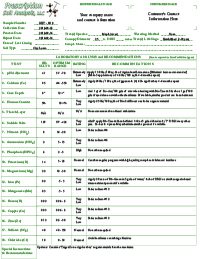Makes sense . . . Sounds logical . . . Simple enough . . . yet most companies that offer PHC services don’t seem to really understand this concept.
Keith here . . .
Or maybe they don’t know that there is an easy way to implement a comprehensive soil health care program.
Or maybe they don’t know that they can make really good money providing soil health care services.
Or maybe they don’t realize that soil care is the secret to Thriving Trees, Superior Shrubs, and Luxurious Lawns.
So this is a follow-up to the previous article about the role of Soil Biology as a critical component of a comprehensive soil health care program.
It has been both a privilege and personally enlightening to talk with hundreds of arborists and other plant health care professionals over the decades at trade shows, seminars and casual meetings. When the topic of their actual PHC program comes up, the vast majority of their programs are comprised of two elements – fertilization and whatever pest controls might be required.
This is not surprising since “conventional wisdom,” seminar speakers, product spokespersons, etc. focus on these two courses of action. I’ve lost count of how many times when speaking with a PHC professional about soil testing, they admit to using it as a “last resort” when the “typical treatments” failed to provide any improvements in the plants being treated. The right soil test used to create a plant and soil specific soil health care program would help the true PHC professional get the correct diagnosis and remedy from the get go. Avoid wasting company and customer resources on “educated guesses.”
Since it has been well documented that 70%-80% of all PHC issues can be traced back to various issues with the soil, it makes sense that soil testing should be the first action step rather than the last. Much in the same way that medical doctors require tests before prescribing treatments.

An effective PHC program will use a comprehensive soil test to create a “Soil Health Care” program. (Note: Not all soil tests provide this information.) Prescription Soil Analysis includes not only data about pH and 12 nutrients, but our data also includes organic matter, compaction, biological indicators and soil type. We even give specific recommendations that are easy to follow and cost effective. Think ‘Prescription’, in the same way that your doctor would write one just for you, for exactly what ails you. I’ll go into more specific details of a Soil Health Care Program in a future newsletter, but here are some general benefits:
- Additional revenue streams.
- Can be combined with other scheduled applications saving time and efficiently making you more money.
- Depending on the specific treatments, they might be applied during windy or wet weather when other applications cannot be attempted.
- Applications might be done prior to the usual start or after the normal end of the season.
- Usually results in improved plant health, thus requiring less pesticide treatments.
- Increases the activity levels of critical soil biology which may help keep certain diseases in-check and make fertilizers more efficient.
- These treatments generally do not require a licensed applicator and could provide initial training for a new tech.
- A plan which yields results where other plans failed may enhance you company’s reputation, help you retain customers, and is more environmentally responsible. This is a program that “Green” folks can really get behind, giving you income streams that would otherwise be out of your reach.
So what are the action steps of a top-notch PHC Program?
- Test with a comprehensive soil test that provides specific recommendations for both the plant and soil.
- Use the soil test recommendation to create a Soil Health Care program.
- Execute the Program.
- Fertilize as prescribed by the recommendations. (Could be 50% less product with better results.)
- Apply control products only as needed using appropriate IPM protocols.
- Enjoy your reputation as a “problem solver,” increased customer satisfaction, referrals and profits.


